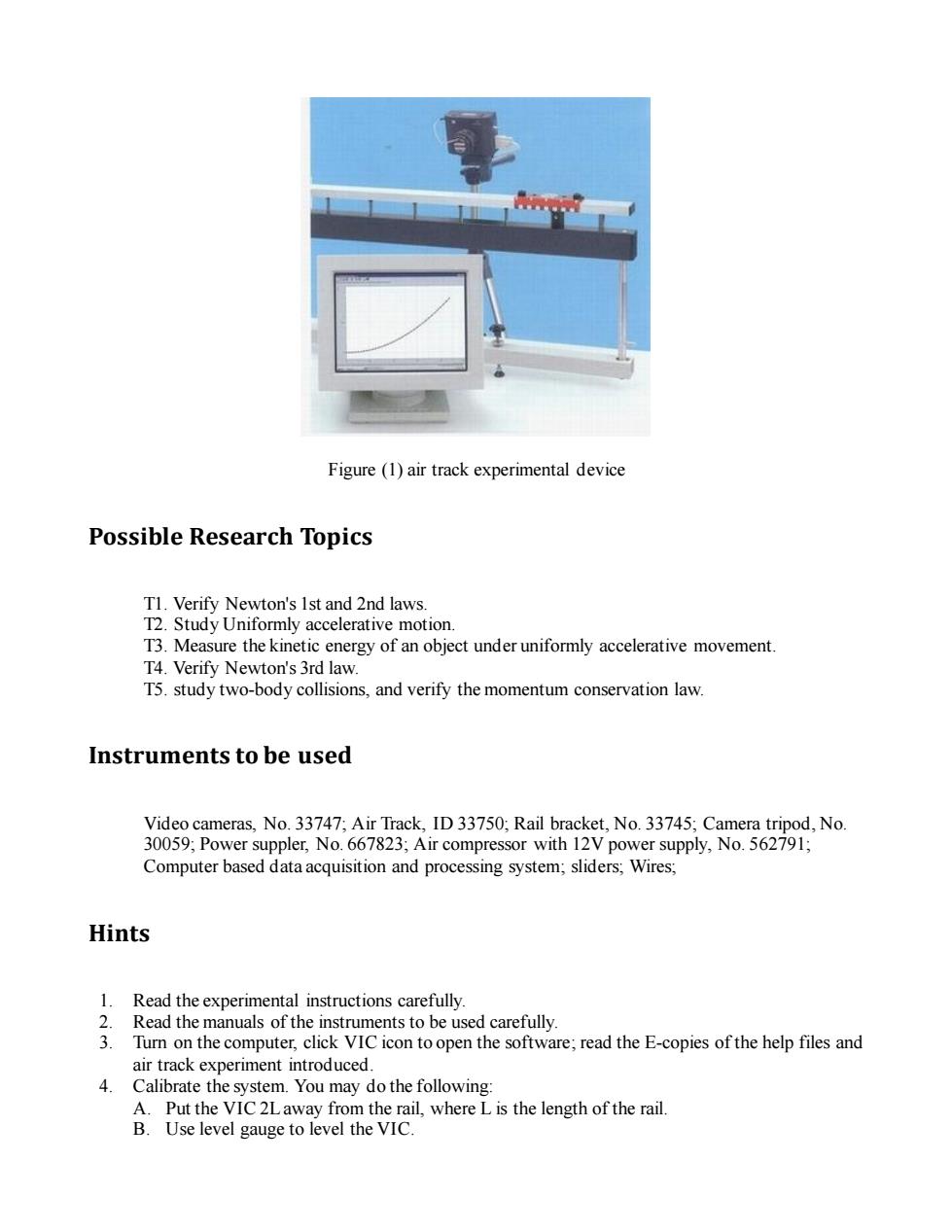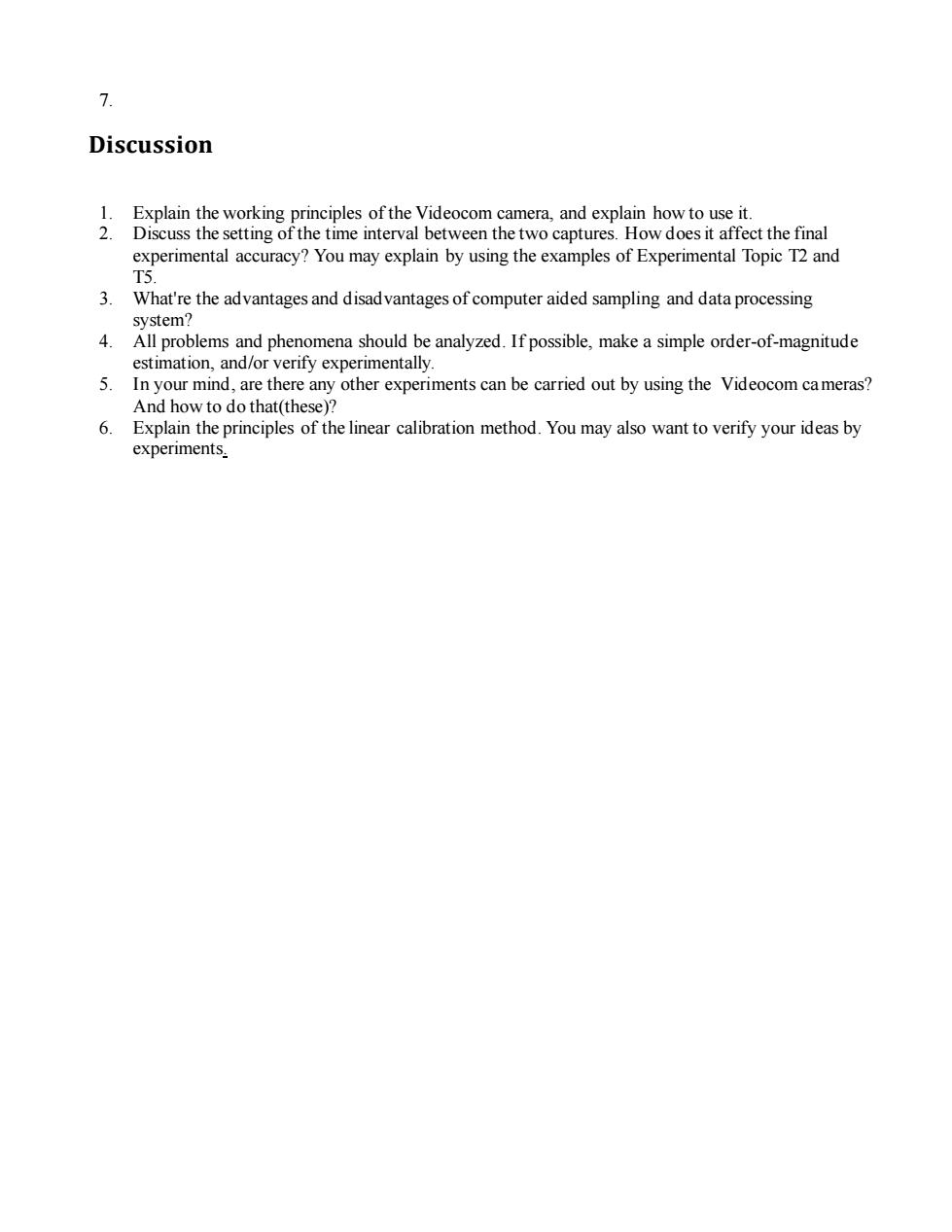
Exp3:Studies of 1D Movement on Air Track Purposes of the Experiment: 1.Study the 1D movement of objects on the air track. 2.Learn how to use "Videocom"camera to measure the movement of objects. 3.Learn how to use computer-aided data acquisition and processing system. Principle of the Experiment: Videocom(VIC)is a camera system which was specifically designed to be connected to a computer.It can collect data by using a single-wire CCD(Charge-Couple Device).The system can record the linear movement with high accuracy. To record the linear motion of objects,shinning reflective foils are pasted on the objects to be studied. LED flash lights can be reflected by the foils.By identifying the light intensity difference between background and the Reflective foils,the VIC can determine the positions of the objects.By taking serial of the positions at different time,one can calculate the object's speed,acceleration,and other related numbers. In many physics experiments,there has an experimental err due to the presence of friction.Even in some cases,the err is so large that the experiment cannot be carried out.In this experiment,an air track is used to reduce the friction.When the slider is moving on the rail,there has a small air gap between the slider and the rail.This air gap can significantly reduce the frictional resistance,so then makes it possible to carry out high accurate studies. As the first step,one should calibrate the system,i.e.,to find the ratio between the length and pixels. For example,if the object moves 1 meter,and there have 1000 pixel shift on the images captured by VIC,the calibrating ratio is 0.001 m/pxl. Linearization can improve the measurement accuracy further.In the linearization method,two identical sliders are measured simultaneously.The measured length should cover the entire rail.The software can automatically calculate the difference between the two data sets,and then obtain correction values. After the linearization,the system should be re-calibrated. The raw experimental is S(t),i.e.positions S at different time t.The software can calculate and display the V(t)and a (t)by default.Using the formula tags,one can calculate and display the combined physical quantity,for example:P(t)=mlv1+m2v2,the momentum of the system.From P(t),one can verify the momentum conservation law.Fig.1 is the experimental setup
Exp3: Studies of 1D Movement on Air Track Purposes of the Experiment: 1. Study the 1D movement of objects on the air track. 2. Learn how to use “Videocom” camera to measure the movement of objects. 3. Learn how to use computer-aided data acquisition and processing system. Principle of the Experiment: Videocom (VIC) is a camera system which was specifically designed to be connected to a computer. It can collect data by using a single-wire CCD(Charge-Couple Device). The system can record the linear movement with high accuracy. To record the linear motion of objects, shinning reflective foils are pasted on the objects to be studied. LED flash lights can be reflected by the foils. By identifying the light intensity difference between background and the Reflective foils, the VIC can determine the positions of the objects. By taking serial of the positions at different time, one can calculate the object's speed, acceleration, and other related numbers. In many physics experiments, there has an experimental err due to the presence of friction. Even in some cases, the err is so large that the experiment cannot be carried out. In this experiment, an air track is used to reduce the friction. When the slider is moving on the rail, there has a small air gap between the slider and the rail. This air gap can significantly reduce the frictional resistance, so then makes it possible to carry out high accurate studies. As the first step, one should calibrate the system, i.e., to find the ratio between the length and pixels. For example, if the object moves 1 meter, and there have 1000 pixel shift on the images captured by VIC, the calibrating ratio is 0.001 m/pxl. Linearization can improve the measurement accuracy further. In the linearization method, two identical sliders are measured simultaneously. The measured length should cover the entire rail. The software can automatically calculate the difference between the two data sets, and then obtain correction values. After the linearization, the system should be re-calibrated. The raw experimental is S(t), i.e. positions S at different time t. The software can calculate and display the V (t) and a (t) by default. Using the formula tags, one can calculate and display the combined physical quantity, for example: P (t) = m1v1 + m2v2, the momentum of the system. From P (t), one can verify the momentum conservation law. Fig.1 is the experimental setup

Figure (1)air track experimental device Possible Research Topics T1.Verify Newton's 1st and 2nd laws. T2.Study Uniformly accelerative motion. T3.Measure the kinetic energy of an object under uniformly accelerative movement. T4.Verify Newton's 3rd law. T5.study two-body collisions,and verify the momentum conservation law. Instruments to be used Video cameras,No.33747;Air Track,ID 33750;Rail bracket,No.33745;Camera tripod,No. 30059;Power suppler,No.667823;Air compressor with 12V power supply,No.562791; Computer based data acquisition and processing system;sliders;Wires; Hints 1.Read the experimental instructions carefully. 2.Read the manuals of the instruments to be used carefully. 3. Turn on the computer,click VIC icon to open the software;read the E-copies of the help files and air track experiment introduced. 4.Calibrate the system.You may do the following: A.Put the VIC 2L away from the rail,where L is the length of the rail. B.Use level gauge to level the VIC
Figure (1) air track experimental device Possible Research Topics T1. Verify Newton's 1st and 2nd laws. T2. Study Uniformly accelerative motion. T3. Measure the kinetic energy of an object under uniformly accelerative movement. T4. Verify Newton's 3rd law. T5. study two-body collisions, and verify the momentum conservation law. Instruments to be used Video cameras, No. 33747; Air Track, ID 33750; Rail bracket, No. 33745; Camera tripod, No. 30059; Power suppler, No. 667823; Air compressor with 12V power supply, No. 562791; Computer based data acquisition and processing system; sliders; Wires; Hints 1. Read the experimental instructions carefully. 2. Read the manuals of the instruments to be used carefully. 3. Turn on the computer, click VIC icon to open the software; read the E-copies of the help files and air track experiment introduced. 4. Calibrate the system. You may do the following: A. Put the VIC 2L away from the rail, where L is the length of the rail. B. Use level gauge to level the VIC

C.Put two sliders separated about 1 m from each other on the rail. D.Adjust until you have the Reflective foil shown in the monitor clearly. E.Adjust the position of the camera,so that the distance between the two slides is shown as one meter. 5. Open an existing experiment file in C:Data file folder.You may have a start point to set the experimental parameters and show experimental data. 6. You may create your own private folder in C:StuData(named with your Student ID).Save your experimental data in your own folder.And create one Text file(use your name as the file name) in the private folder as your experimental record document. 7. Select the Settings icon,and set the parameters.Figure(2)is an example of setting the experimental parameters. 60a8⊙可@ 15 Eg.o coinm 习 Va Saeero y卫 n 卖到R-4:Filcee B4他=2:g-新3形酒度 8.Carry out the Research Project (T1):Put hard wares to the right positions;Set experimental parameters in software.Ask your instructor to confirm the setting.And then carry out the experiment.Save the data in the private folder;Copy and save the computer screen into your folder,Take experimental records and save. 9. Select few topics from"Research Topics"part,or propose their own research topic to complete the experiment,the relevant document number stored in the private folder,credited to the experimental situation memo file. 10.Copy the private folder in the relevant documents,select the appropriate data processing,to complete the lab report. Caution 1.Before the experiment,you should read the instruments'manuals carefully.Make sure you know how to operate the instruments well enough. 2.Keep the CCD lens clean,or you will get strong stray light. 3.Keep the reflective foil stored in a cool,dry place.And also avoid scratching. 4.The rail must be leveled,and cleaned before the experiment.The slider and all attachments must be restored into the accessory box after using. 5.Check air holes carefully,to ensure every hole unimpeded.A blocked hole will ruin your efforts. 6. Floppy disk must be formatted before using,Ask your instructor to ensure that
C. Put two sliders separated about 1 m from each other on the rail. D. Adjust until you have the Reflective foil shown in the monitor clearly. E. Adjust the position of the camera, so that the distance between the two slides is shown as one meter. 5. Open an existing experiment file in C: \ Data file folder. You may have a start point to set the experimental parameters and show experimental data. 6. You may create your own private folder in C: \ StuData (named with your Student ID). Save your experimental data in your own folder. And create one Text file (use your name as the file name) in the private folder as your experimental record document. 7. Select the Settings icon, and set the parameters. Figure (2) is an example of setting the experimental parameters. 8. Carry out the Research Project (T1): Put hardwares to the right positions; Set experimental parameters in software. Ask your instructor to confirm the setting. And then carry out the experiment. Save the data in the private folder; Copy and save the computer screen into your folder; Take experimental records and save. 9. Select few topics from “Research Topics” part, or propose their own research topic to complete the experiment, the relevant document number stored in the private folder, credited to the experimental situation memo file. 10. Copy the private folder in the relevant documents, select the appropriate data processing, to complete the lab report. Caution 1. Before the experiment, you should read the instruments’ manuals carefully. Make sure you know how to operate the instruments well enough. 2. Keep the CCD lens clean, or you will get strong stray light. 3. Keep the reflective foil stored in a cool, dry place. And also avoid scratching. 4. The rail must be leveled, and cleaned before the experiment. The slider and all attachments must be restored into the accessory box after using. 5. Check air holes carefully, to ensure every hole unimpeded. A blocked hole will ruin your efforts. 6. Floppy disk must be formatted before using, Ask your instructor to ensure that

7. Discussion 1.Explain the working principles of the Videocom camera,and explain how to use it. 2.Discuss the setting of the time interval between the two captures.How does it affect the final experimental accuracy?You may explain by using the examples of Experimental Topic T2 and T5. 3.What're the advantages and disadvantages of computer aided sampling and data processing system? 4.All problems and phenomena should be analyzed.If possible,make a simple order-of-magnitude estimation,and/or verify experimentally. 5.In your mind,are there any other experiments can be carried out by using the Videocom cameras? And how to do that(these)? 6.Explain the principles of the linear calibration method.You may also want to verify your ideas by experiments
7. Discussion 1. Explain the working principles of the Videocom camera, and explain how to use it. 2. Discuss the setting of the time interval between the two captures. How does it affect the final experimental accuracy? You may explain by using the examples of Experimental Topic T2 and T5. 3. What're the advantages and disadvantages of computer aided sampling and data processing system? 4. All problems and phenomena should be analyzed. If possible, make a simple order-of-magnitude estimation, and/or verify experimentally. 5. In your mind, are there any other experiments can be carried out by using the Videocom cameras? And how to do that(these)? 6. Explain the principles of the linear calibration method. You may also want to verify your ideas by experiments